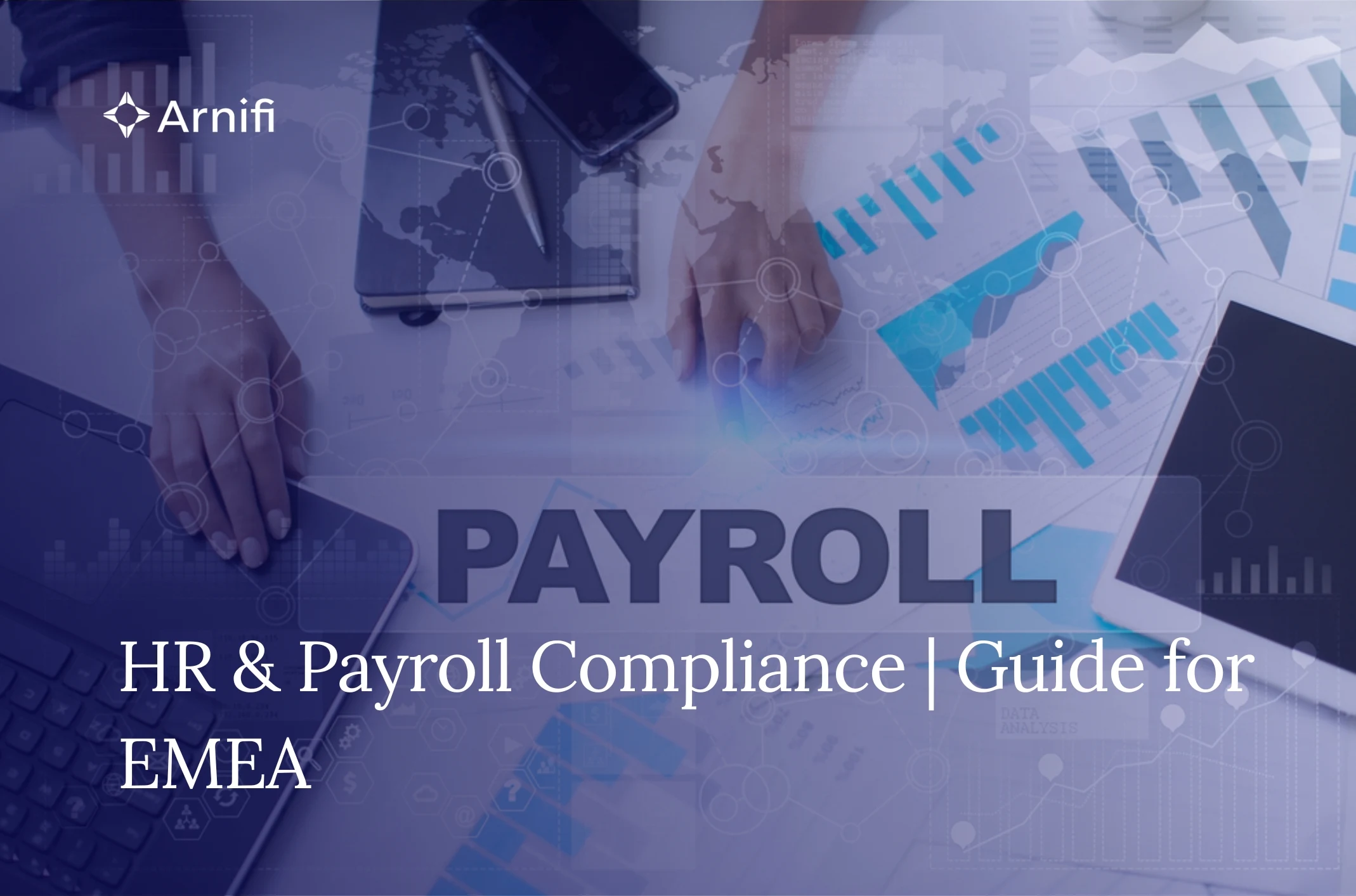How To Manage Currency Exchange Rates When Processing Payroll in Dubai, UAE
by
Ishika Bhandari
Nov 18, 2025  7 MIN READ
7 MIN READ

Table of contents
- Why Exchange Rate Management Matters in UAE Payroll
- How Payroll Systems Commonly Handle Currency Exchange
- Challenges Dubai Companies Face With Multi-Currency Payroll
- Best Practices To Manage Currency Exchange Rates Effortlessly
- Why Dubai Businesses Prefer Centralized Payroll for Multi-Currency Processing
- How ArnifiHR Solves Currency Exchange Issues for UAE Companies
- Step-by-Step Guide: Setting Up a Smooth Multi-Currency Payroll Workflow
- FAQs
- Conclusion
Payroll management in Dubai becomes even more tedious with all the international hiring, the processing of payments made to remote teams in different currencies, and the world of contractors across GCC, Asia, and Europe. In themselves, the globality of workforces creates a new operational challenge for HR and finance teams: how to manage currency exchange rates and payroll without errors, delays, or unexpected cost fluctuations.
This links naturally to the earlier discussion on centralized payroll vs decentralized payroll systems in the UAE. In general, centralized payroll structures will treat multi-currency calculations in a unified and consistent way; on the other hand, decentralized or department-managed systems depend more on manual conversion, use different sources of available FX, and vary in rates used, all of which cause very serious payroll discrepancies.
In a place like Dubai, where compliance timelines are tight and accuracy on payroll is measured by employee trust, mastering currency management becomes mandatory, not an option.
Why Exchange Rate Management Matters in UAE Payroll
The UAE and especially Dubai are unique in terms of employee profiles:
- Remote employees from other GCC, Europe, South Asia, and Africa
- International payments to contractors are made in dollars, euros, and Asian currencies
- Mandatory requirements in terms of payroll with respect to WPS for local employees
The salaries of employees can be paid in one currency and paid in another; thus, companies have to constantly deal with the reality of fluctuating exchange rates that may or may not really influence the import of values attached to salaries and whether they are underpaid or inflated unexpectedly, concerning payroll costs.
Here are the major problems that arise in a business without proper management of FX:
- WPS compliance issues if AED amounts differ from the required wage records
- When payroll projections do not match actual bank debits, cash flow misalignment
- Employee dissatisfaction due to fluctuating take-home pay
- Accounting inconsistencies across payroll cycles
This is why Dubai companies increasingly rely on structured systems for multi-currency payroll in the UAE, ensuring predictable outcomes every month.
How Payroll Systems Commonly Handle Currency Exchange
To manage currency exchange rate payroll effectively, companies usually introduce one of the following approaches:
1. Fixed Monthly Rate
One rate is secured at the beginning of the month and applied to every payroll calculation within that period
Pros: Predictability and stability
Cons: Risk of misalignment with real-time rates if the market moves sharply
2. Real-Time Spot Rates
Based on live rates pulled automatically from banking partners or FX providers
Pros: Highly accurate and up-to-date
Cons: Monthly payroll costs may vary
3. Contractual or Negotiated Rates
The margin by which FX is converted when buying bank payments or payments to other providers is negotiated
Cons: Larger companies benefit most
4. Bank-Driven Rates
Their own conversion rate is applied by banks when they pay salaries
Pros: Simple but
Cons: Often leads to unpredictable payroll costs and inconsistent salary amounts
Controversies start emerging when the two localized payroll teams handle different approaches. One department uses a spot rate, another department employs last month’s rate, and a third one converts it manually. Some of the biggest reasons for FX payroll errors fall into the category of lack of standardization.
This centralized payroll system thus prevents uncertainty by applying one consistent method across the entire organization.
Challenges Dubai Companies Face With Multi-Currency Payroll
Dubai companies face repeated challenges when handling multiple currencies for salaries:
1. Rate Fluctuations Affect Salary Value
The most common experience from month to month for employees paid in their own home currency is different take-homes or sometimes totally wrong values, leaving room for the buildup of frustration and distrust.
2. Manual Conversions Create Errors
The traditional method of conversion through spreadsheets is risky, prone to typing errors, and harder to follow and audit.
3. Unexpected Payroll Overruns
By weakening the AED or strengthening the target currency, the payroll cost can deceitfully surge.
4. Payment Delays Due to FX Mismatches
Differences between the rates produced in the calculated payroll and those applied by the bank can result in delays in payment processing.
5. WPS Compliance Risks
If the AED equivalents do not match those of the WPS file, the payment may be rejected, putting a company at risk concerning compliance.
To compound the problem further, it gets multiplied when the companies depend on fragmented teams or rely on manual processes. This explains why multi-currency payroll in the UAE stands as one of the strongest arguments against decentralized payroll. It certainly stands tall among the many strong arguments for centralized payroll in converting from a decentralized payroll system to a centralized payroll system.
Best Practices To Manage Currency Exchange Rates Effortlessly
Here are the best practices most suited to the UAE to make multi-currency payroll simpler:
1. Use a Centralized Payroll Platform
Ensures FX rules are unified and are uniformly applied across the teams
2. Standardize Exchange Rate Policies
Set a clear policy:
- Fixed monthly rate
- Weekly average
- Real-time FX feed
- Choose one and apply it company-wide
3. Automate Currency Conversions
Payroll solutions containing built-in FX automation require less manual work while minimizing possible human error
4. Lock in FX Rates Where Helpful
Locking rates for a period calms salary expectations for budgeting on volatile currencies
5. Build Buffers for Volatile Currencies
Small buffers can protect against unexpected market swings without dampening employee earnings
6. Integrate Payroll With Banking Partners
Direct integration ensures bank-applied FX aligns with payroll-calculated FX
7. Maintain Clear Audit Trails
Transparent logs of rate and calculations are necessary for audits and WPS inspections in the UAE
Following these procedures ensures that businesses comply, remain stable, and remain predictable.
Why Dubai Businesses Prefer Centralized Payroll for Multi-Currency Processing
After contrasting centralized versus decentralized payroll arguments in previous articles, currency management preferred the reasoning:
Centralized Payroll Offers:
- One source of truth
- Consistent FX handling
- Automated conversions
- Lower human error
- Unified reporting
- Better control and oversight
Decentralized Payroll Struggles With:
- Multiple FX sources
- Conflicting rate application
- Manual uploads and spreadsheets
- No unified approval trail
- Slower payroll cycles
A centralized payroll system is largely favored for FX payroll processing among companies operating in DIFC, free zones, or on the mainland, especially with remote and international teams.
How ArnifiHR Solves Currency Exchange Issues for UAE Companies
ArnifiHR, designed specifically for modern and global UAE businesses, has a smooth handle on multi-currency payroll. It tackles the biggest FX issues with the following advantages:
1. Auto-Updated FX Rates
2. Unified Rules Across All Employee Types
3. Multi-Country Salary Management
4. Transparent Rate Logs for Compliance
5. Integrated Payments
6. Real-Time Payroll Cost Simulation
Step-by-Step Guide: Setting Up a Smooth Multi-Currency Payroll Workflow
We have designed a pragmatic workflow for establishing an efficient multi-currency payroll process:
- List all currencies needed across employees, contractors, and regions
- Set an FX policy that is uniform, whether fixed, spot, negotiated, or hybrid
- Establish a frequency for updating rates (daily, weekly, or monthly)
- Define workflows for approving rate changes and payroll processing
- Link payroll with the bank/payment partners for real-time confirmation
- Conduct a dry run of the monthly cycle to test it before going live
- Create automated FX reporting for audit and compliance
This workflow is designed on the fundamental tenet that consistency will eventually lead to accuracy.
FAQs
1. How do UAE companies choose the right exchange rate for payroll?
Most choose between a fixed monthly rate or a real-time bank-integrated rate, depending on volatility and contract terms.
2. Can I pay international employees in their home currency?
Yes, as long as the AED equivalent for UAE staff complies with WPS.
3. Does WPS support multi-currency payroll?
WPS requires AED payments locally, but international employees and contractors can be paid in their home currencies.
Conclusion
Payroll is a big challenge when it comes to effectively managing FX, and an equally easy opportunity for expensive mistakes. In the multi-currency payroll space in Dubai, manual or decentralized systems create even more compliance issues and unpredictable payroll costs.
By using a centralized, automated payroll such as ArnifiHR, firms can achieve accuracy, transparency, and control. With unified FX rules, automated conversions, and easily managed across multiple countries, businesses can focus on payroll currency exchange rates and remain compliant in the UAE.
Top UAE Packages

Related Articles
Top UAE Packages



